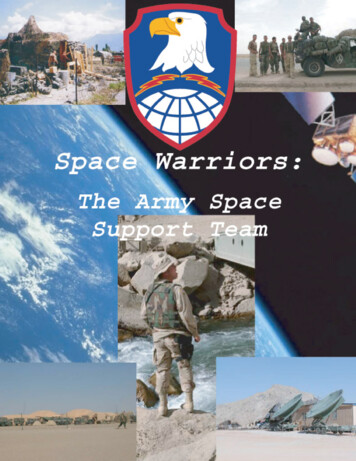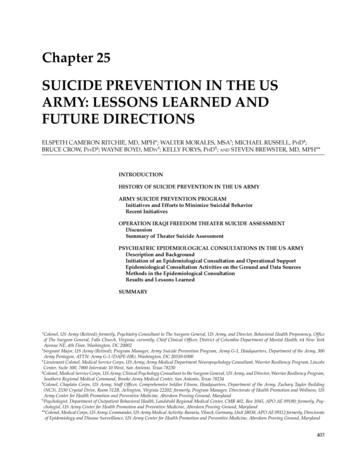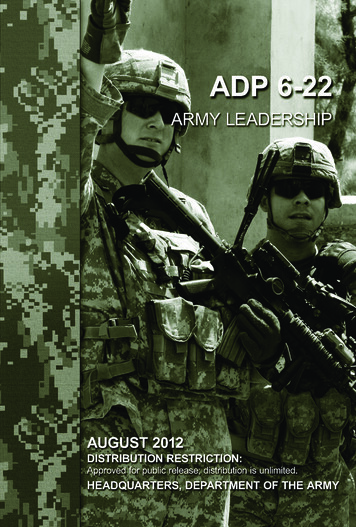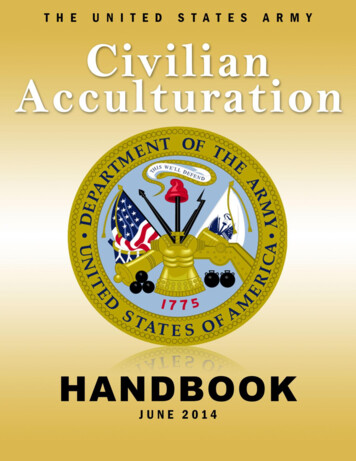
Transcription
SPACE WARRIORS:THE ARMY SPACE SUPPORT TEAMPrepared by:Dr. James Walker&James T. HooperMarch 1999, July 2003 (rev.)
FOREWORDIn the fifteen years since the U.S. Army SpaceCommand (USARSPACE) was activated, soldiersfrom this command have pioneered innovative andrevolutionary ways for employing space capabilitieson behalf of the warfighter. At the time this historywas sent to press, Army space soldiers were deployedworldwide in support of a variety of critical missions.Army space support units were present during combatoperations in Afghanistan in 2001 and Iraq in 2003,providing force enhancement, missile attack warning,and information operations support to commanders inthe U.S. Central Command area of operations. OtherArmy space soldiers, working in both the United States and overseas, delivered theworldwide long-haul satellite communications support and other space productsneeded to maintain an effective military deterrent in Korea and other areas. Asthese examples attest, Army space soldiers are today playing an important roleacross the entire spectrum of operations.This history considers the establishment and subsequent evolution of the ArmySpace Support Team (ARSST) organization, created to provide space products andexpertise to field units, thereby enhancing their intelligence and operationalplanning capabilities. This history focuses on the period from 1986 to 1998, whena handful of soldiers and civilians experimenting with new technologies andconcepts sought to leverage the “ultimate high ground” on behalf of the land force.The history discusses the hard-won lessons learned through repeated deploymentsand exercises, calling attention to their frustrations and setbacks as well as to theirmany successes. Ultimately, it seeks to explain how those early visionariesestablished a foundation for the progress that the Army has achieved over the pastfive years, as illustrated by the importance of space in today’s land combatoperations, and how these early lessons continue to provide valuable insights forthe Army as it transforms for the future.This history was originally written in 1998. We are publishing it now, with a newconcluding chapter, because developments over the past five years underscore theimportance of the early work accomplished by ARSST soldiers. In areas rangingfrom the formulation of space doctrine and operational concepts to theestablishment of a new career field and Army space force structure, earlyexperimentation by ARSST soldiers provided the foundation for subsequent Armyinitiatives. It is our hope that this early history of ARRST from 1986 to 1998 willcontribute to a more complete understanding of the progress made since 1998, andto an informed vision of the future of Army space support.Why should soldiers read this book? All military operations today are affected byspace-based communications, imagery, positioning and location support, missilewarning, and related capabilities. As the Army transforms itself for the future,Space Warriors: The Army Space Support Teamii
space will be essential for achieving the information dominance necessary for theadvanced, full-spectrum Army operations of tomorrow. An understanding ofspace systems and capabilities is becoming an increasingly important part of theprofessional soldier’s craft, and we hope that this history will provide new andimportant insights into where we have come from and where we are going as anArmy.Joseph M. Cosumano, Jr.Lieutenant General, U.S. ArmyCommandingSpace Warriors: The Army Space Support Teamiii
PREFACEThis history of Army Space Support Team (ARSST) operations was written tosupport soldiers—both present and future—as they seek new and better ways touse space as a force multiplier. The original publication of this history in 1998came just two years before a dramatic restructuring of the nation’s spaceorganizations and equally dramatic changes in the national security environment.These changes have impacted and continue to impact the organization and scopeof Army space support capabilities. In such an environment of rapid andcontinuous change, it is both interesting and useful to examine the past to gain anunderstanding of the historical foundations for some of these new ideas andorganizations. It is hoped that this history of the Army Space Support Team willprovide the reader with such an understanding.The history is dedicated to the soldiers of the Army Space Support Team. Sincethe ARSST was activated in October 1994, these soldiers have deployed to supportwarfighting units, experimented with new tactics and advanced technologies and,in the process, established a firm foundation for Army space initiatives extendinginto the next century. If, as many analysts claim, the United States is at theforefront of a ‘Revolution in Military Affairs,’ it is largely due to the efforts ofsoldiers such as these.This history represents the efforts not only of the authors, but also of a number ofsoldiers and civilians whose roles must be acknowledged. Without thesponsorship of Colonel Steve Bowman [Chief of Staff, U.S. Army SpaceCommand (USARSPACE)] and the support of the entire USARSPACEleadership, this study would never have been conducted. Both Colonel Bowmanand Lieutenant Colonel Bob Simmons [Director of Current Operations,USARSPACE] provided extremely useful guidance and input. Many Army SpaceSupport Team personnel provided exemplary support throughout the study,answering thousands of questions, helping gather data, and discussing their fieldexperiences and space support insights in a series of oral history interviews. It issafe to say that this history would never have been completed without theassistance of Lieutenant Colonel LeRoy Maurer, Lieutenant Colonel FrankieMoore, Major Gwynne T. Burke, Major Scott Cuthbertson, Major Caesar Jaime,Major Michael McFarland, Captain Gerry Skaw, Captain David Strombeck,Sergeant First Class Howard Smith, Staff Sergeant William Bates, Staff SergeantMark Stroup, and Sergeant Eric Herrmann. Similarly valuable research supportwas provided by Mr. Gary Baumann [USARSPACE], Mr. Ed Kiker [formerlyassigned to the Army Space Institute], and Mr. James Williamson [BrownInternational]. Finally, special thanks is due to Major Caesar Jaime who providedlogistical support throughout the study process, arranged and scheduled interviewswith a number of subject matter experts, and provided a conduit for the exchangeof information between various elements of U.S. Army Space Command.During the analysis and production phases of this project, assistance was renderedby a number of analysts whose efforts should also be acknowledged. Mr. RoyMcCullough of Science Applications International Corporation (SAIC) madeSpace Warriors: The Army Space Support Teamiv
significant editorial contributions to the 2003 edition of this history. Reviews,input, advice, and guidance for the original edition of the history, prepared in1998, were also provided by a number of personnel at SAIC, including RandyJones [Lieutenant Colonel, USA (ret.)], Doug Brisson [Lieutenant Colonel, USA(ret.)], Chip Fackner [Colonel, USA (ret.)], Tom Molino [Colonel, USA (ret.)],and Jim Reams [Lieutenant Colonel, USA (ret.)]. In addition, research support,editorial assistance, and graphics development help were provided by Dr. ToddClark [SAIC], Mrs. Sharon Lang [Historical Office, U.S. Army Space and MissileDefense Command (USASMDC)], Ms. Sherrye Alexander [Historical Office,USASMDC], Mr. Joe Kupsky [SAIC], Mr. Mike Gallardo [SAIC], Mr. MarkTorok [SAIC].All ranks are given as they were at the time of the preparation of this study.Dr. James WalkerJames T. HooperSpace Warriors: The Army Space Support Teamv
CONTENTSEXECUTIVE SUMMARY .xCHAPTER ONE: SPACE COMES TO THE WARFIGHTER .1INTRODUCTION .2TRAILBLAZING EFFORTS AT THE ARMY SPACE INSTITUTE.3BACKGROUND: THE ACTIVATION OF THE U.S. ARMY SPACE COMMAND.5LESSONS LEARNED: THE ARMY SPACE INSTITUTE EXPERIENCE.6FROM TESTING AND DEMONSTRATION TO TACTICAL CAPABILITIES: THEFIELDING OF GPS AND THE GULF WAR.6GPS Overview .7The GPS Testing And Development Process – Army Involvement.8The GPS In Desert Shield And Desert Storm.9Lessons Learned During GPS Fielding And Employment .11FIELD EXPERIENCE AND THE OPERATIONALIZATION OF SPACE .13Satellite Communications .13SATELLITE WEATHER SUPPORT.15Satellite Topographic Imagery.17Theater Missile Attack Warning.18Key Lessons In Bringing Space To The Warfighter.19SUMMARY .22CHAPTER TWO: ESTABLISHMENT DECISIONS SHAPING ARSSTACTIVATION AND THE INITIAL CONOPS .31THE LOUISIANA MANEUVERS .31THE LOUISIANA MANEUVERS .32THE COMMERCIAL SPACE PACKAGE.33Background .33Early Decisions .33The Louisiana Maneuvers General Officer Working Group Meeting.35Senior-Level Review And Refinement Of The CSP Initiative.38Implementation: Procurement Actions For The CSP .40COPS: THE CONTINGENCY OPERATIONS (SPACE) TEAM.41The Army Audit Agency Review Of 1994 .41Standing Up The COPS Capability.42Developing The COPS Concept Of Operations.43USSPACECOM And The Renaming Of COPS .46Space Warriors: The Army Space Support Teamvi
THE TRANSITION TO ARSST (OCTOBER TO DECEMBER 1994) . 48SUMMARY . 49CHAPTER THREE: EVOLUTION OF ARSST OPERATIONS . 55ARSST OPERATIONS AND EVOLUTION, 1995 . 561995 Concept Of Operations. 56ARSST Field Deployments. 57XVIII Airborne Corps Support . 591995 ARSST Lessons Learned . 64ARSST OPERATIONS AND EVOLUTION, 1996 . 641996 Concept Of Operations. 65ARSST Planning, January 1996. 65Space Demonstration Program Planning, January 1996 . 68ARSST Field Deployments, 1996. 68ARSST Forward Deployment At Ft. Bragg. 72July-August 1996: ARSST Division Long Range Planning. 73Changes To The ARSST TDA, July 1996 . 761996 ARSST Lessons Learned . 77ARSST OPERATIONS AND EVOLUTION, 1997 . 781997 Concept Of Operations. 79ARSST Field Deployments, 1997. 79ARSST Self-Sustainment Capability . 83ARSST Reorganization – The Commanding General’s Briefing . 84Changes To The MOA With The XVIII Airborne Corps . 92The Army Space Support Cell (ARSST Plus) Concept . 931997 ARSST Lessons Learned . 96ARSST OPERATIONS AND EVOLUTION, 1998 . 971998 Concept Of Operations. 97ARSST Field Deployments, 1998. 981998 ARSST Training . 102USARSPACE Long Range Planning. 104The Redeployment Of ARSST Team 4 To Colorado Springs. 1061998 ARSST Lessons Learned . 106SUMMARY . 108CHAPTER FOUR: KEY TRENDS AND ISSUES . 115EVOLUTION OF THE ARMY SPACE SUPPORT STRUCTURE. 116Organization And Programs. 116Army Space Support: Intellectual Evolution . 117Space Warriors: The Army Space Support Teamvii
The Bottom Line: The Army Has A Demonstrated Need For A DeployableSpace Support Organization .118ARSST RESOURCE CONSTRAINTS AND TRADEOFFS .118The Bottom Line: A Requirement For Resources .121THE VIEW FROM THE FIELD: HOW SUPPORTED UNITS RATE ARSSTSUPPORT .121After-Action Reports And Observations From The Field .121The Bottom Line: Officers Who Have Trained With An ARSST AreImpressed With The Value Of Space Support.123SPACE SUPPORT AND LESSONS LEARNED ANALYSIS .124The Original ARSST Reporting And Collection Process.124Implications Of The Failure To Capture ARSST Lessons Learned .125The Bottom Line: A Systematic Process Should Be Established ToDisseminate Space Support Lessons Learned Throughout The Total Army.125THE ARSST AND SPACE EDUCATION .126CURRENT SPACE EDUCATION .126Future Army Space Education .127The Bottom Line: Continued Emphasis Should Be Placed Upon TheDevelopment Of Space Education And Training Programs .127THE ARSST AND SPACE DEMONSTRATION .129The ARSST And Space System Demonstration Missions .129The Bottom Line: The ARSST Should Continue To Demonstrate New SpaceSystems .130SUMMARY .131CHAPTER FIVE: FUTURE ARSST EVOLUTION .135THE ARSST LONG RANGE VISION, 1996-1998.136ARSST Long Range Vision: January 1996 .136ARSST Long Range Vision: July 1996 .136ARSST Long Range Vision: 1997.137ARSST Long Range Vision And Planning Thrusts: 1998 .137THE ARSST LONG RANGE VISION: COMMON THEMES (1996-1998).138ARSST Long Range Planning Assumptions, 1998 .139VISIONS FOR LONG TERM SPACE SUPPORT EVOLUTION .140THE LONG TERM VIEW FROM THE ARSST: AREAS OF CONSENSUS .141THE LONG TERM VIEW FROM THE ARSST: UNRESOLVED ISSUES.143FUTURE ORGANIZATIONAL CONSTRUCTS.145SUMMARY .149Space Warriors: The Army Space Support Teamviii
CHAPTER SIX: CONCLUSIONS . 153BIBLIOGRAPHY . 159APPENDIX ONE: ARSST EQUIPMENT . 165The Commercial Space Package. 165The High Resolution Weather Satellite Receiver (HRWSR) . 166The Mission Planning Rehearsal System (MPRS) . 168INMARSAT Communications Terminals . 169The Multi-Spectral Imagery Processor (MSIP) . 170Upgraded and New ARSST Equipment. 171THE SPACE SUPPORT PLATFORM (SSP). 171THE SPACE SUPPORT PLATFORM PLUS (SSP ). 172THE MULTI-SOURCE TACTICAL SYSTEM (MSTS) . 172THE LAPTOP VISUALIZATION DEVICE (LVD). 173THE ALL SOURCE ANALYSIS SYSTEM—WARLORD (ASAS WARLORD) . 173ARSST COMMUNICATIONS . 174APPENDIX TWO: ACRONYMS . 179Space Warriors: The Army Space Support Teamix
EXECUTIVE SUMMARYIn the period from 1986 to 1998, the Army experimented with a number ofconcepts and programs for providing space support to tactical commanders.During this period, the focus of Army efforts shifted from space systemsdemonstrations, to deployment support, to space analytic services. The ArmySpace Support Team (ARSST) spearheaded these efforts to utilize spacecapabilities in support of the warfighter. As the military space environmentcontinues to evolve and the Army adapts to new and emerging Army requirements,the ARSST will continue to play an indispensable role in translating spacecapabilities into warfighting tools and knowledge.The primary goal of this history of the Army Space Support Team is to supportdecision-making—both present and future—by outlining the organizational andconceptual evolution of the ARSST from 1986-1998, identifying trends and issuesof significance, and explaining how important problems were approached and whykey decisions were made.ARSST Origins and BackgroundThe Army Space Support Team organization represents the culmination of twelveyears of Army conceptual development and field experience in applying space tosupport tactical units. This historical background was punctuated by six keymilestones, as summarized below:1986: The provisional activation of the Army Space Institute (ASI). As thecoordinating body for the development of Army space concepts, doctrine, training,and equipment, ASI served a pivotal role in first introducing the Army to thebenefits offered by space.1987: The decision to implement the Army Space Demonstration Program.The demonstration program provided an early education to many tacticalcommanders on methods of using space technologies to support planning andoperations. Although this program was not designed, organized, or funded toprovide operational support in the field, personnel later deployed in support ofArmy operations in Saudi Arabia, Haiti, and Bosnia.1988: The activation of U.S. Army Space Command (USARSPACE). Thismarked the end of a long evolutionary process that began with the activation of afour-man liaison element at Colorado Springs in 1984 and continued through 1988when USARSPACE was established as the central organization for providingoperational space support to the Army.1990-1991: The DESERT SHIELD and DESERT STORM experience. In thedeserts of Saudi Arabia, Kuwait, and southern Iraq, the “rank-and-file” Army wasexposed to the value of multi-spectral imagery, GPS position/navigation, satelliteweather, ballistic missile warning, and satellite communications. In addition, thisexperience also demonstrated the need for the Army to activate a dedicated spaceSpace Warriors: The Army Space Support Teamx
support organization capable of providing training and operational support to unitsdeployed in a theater of operations.1994: The Army’s decision to activate a deployable space support team(Contingency Operations—Space or COPS) at Colorado Springs. The COPSteam was the first Army organization explicitly designed to provide sustainedoperational support for units in the field.1994-1998: The evolution and growth of the Army Space Support Team. TheARSST represented an extension of the original COPS idea for a deployable spacesupport organization. Over the subsequent five years of ARSST operations, teamsdeployed worldwide to support units from battalion to theater level — and allechelons in between. Equally as important, the ARSST served as a conduitbetween the capabilities of USARSPACE and the needs of warfighting units.ARSST OperationsField units evaluated the quality and value of ARSST support highly. In a 1998survey of Army officers who trained with an ARSST team every respondent statedthat, if deployed to war, he would request assistance from the Army Space SupportTeam. Typical comments included: “I still firmly believe that ARSSTs are truly aforce multiplier and bring a wealth of space systems support” and “I am a believerin the capabilities made available by the ARSST.” ARSST personnel workeddiligently to earn the trust of supported commanders and staffs, demonstrate thevalue of space systems and capabilities, and remain prepared to deploy within 48hours to support the full spectrum of Army missions. In the process, the membersof the ARSST averaged more than 140 deployment days per year.1995: On 1 January 1995, the ARSST was officially activated and teams begandeploying to the field to provide space support enhancement. The ARSST wasinitially divided into three teams, each aligned with a Combatant Command. Overthe course of the year, a team was forward-deployed at Ft. Bragg to satisfy theheavy demands for support made by the XVIII Airborne Corps and specialoperations units.1996: The ARSST concept of operations and organizational structure underwentsignificant changes in 1996. Efforts were made to restructure the ARSST tosupport two Major Regional Conflicts, provide new systems and technologies tothe teams, and enhance space advisory and liaison capabilities.1997: ARSST operations in 1997 were conducted under a new organizationalconstruct, with five teams prepared to support each of the Corps Headquarters andU.S. Army Special Operations Command. The ARSST continued to explore waysto improve the level of space support, to include the forward deployment ofARSST teams and liaison personnel, the rotational deployment of teams, and theestablishment of a self-sustainment capability. Additionally, USARSPACE beganto experiment with the Army Space Support Cell (ASSC) concept.1998: During this year, the ASSC concept was exercised and tested. As part ofthis process, the Command took steps to develop a more formalized trainingSpace Warriors: The Army Space Support Teamxi
program for ARSST personnel. In another development, the forward-deployedARSST team at Ft. Bragg was reassigned to Colorado Springs.Looking to the Future: ARSST Viewpoints in 1998By 1998, long range planning for the Army Space Support Team was based uponfour key assumptions. First, the space capabilities of U.S. adversaries wereexpected to continue to improve. Second, the dependence of the United Statesupon space systems—both commercial and military—would also rise. Third,commercial space capabilities would expand, with a number of implications formilitary operations. Finally, a revolution in satellite communication systemswould introduce new considerations for military command and control. Giventhese trends, ARSST personnel in 1998 strongly believed that the Army needed tobe closely involved in exploiting space systems and capabilities in the future. Tosupport this requirement, the ARSST sought to evolve into a space analysisfocused organization, capable not only of translating space capabilities into toolsfor the supported commander but also of understanding the threat from neutral andadversary space systems, fully exploiting the capabilities of U.S. and commercialspace assets, anticipating space environmental impacts, proactively identifying andaddressing U.S. vulnerabilities and opportunities, and developing a "spaceestimate" for incorporation into the warfighter’s planning process.Looking at the long-term trends in the military space environment and the Army’srequirements for space support, personnel assigned to the ARSST described threefuture organizational constructs for the teams. Under the first concept, the ARSSTwould continue to deploy as a task-organized team of space personnel, but wouldhave self-contained and integrated equipment, mounted in a tactical vehicle.Under the second concept, technology would evolve to the point where a singlesoldier would be capable of providing the full spectrum of space support through asmall laptop computer. Under a third vision of long term ARSST evolution, thesuccessful implementation of space education throughout the Army coupled withthe assignment of space operations officers on Corps and Division staffs wouldrender the ARSST unnecessary. In other words, space analysis would be part ofevery Division and Corps Headquarters’ integral capabilities.Each of the visions for future evolution of the ARSST was dependent upon anumber of variables—the future threat, the evolution of space technology, thedevelopment of Functional Area 40 and the introduction of a space operationsofficer to the field, and the level of resources allocated to space support and spaceoperations by the Army. No matter how the military space environment evolves inthe future or how the Army organizes the ARSST to address it, however, one factremained unchanged: The Army Space Support Team experience established afirm foundation for the application of space on behalf of the warfighter. For yearsto come, this experience will guide how the Army addresses space at the tacticaland operational levels of war.Space Warriors: The Army Space Support Teamxii
CHAPTER ONE:SPACE COMES TO THE WARFIGHTER“While the ultimate weapon of war is still the soldier with a trench-knife, thosesoldiers are precious and few. Space helps to preserve them, make them morelethal, get them to where they are needed on time, get them resupplied with enoughand on time, and convince potential adversaries that these are soldiers who wouldmake better friends than enemies.”-Ed Kiker, Army Space Institute, 19921In October 1994 General Joseph Ashy, Commander-in-Chief of U.S. SpaceCommand (USSPACECOM), directed that a closer relationship be forgedbetween the unified command and its Service components. Shortly thereafter,USSPACECOM and each of its Service components formally activated SpaceSupport Team organizations. This chapter examines early Army efforts to bringspace products to the tactical and operational level, focusing upon key structuralcauses for the Army’s interest in activating a Space Support Team capability.Specifically, this chapter assesses: The impact of Army Space Institute (ASI) efforts to bring space products tothe tactical user, to include the establishment of a successful tactical spacedemonstration program. Key lessons learned during the deployment and use of early space systems,using the Army’s experience with the Global Positioning System (GSP) asan illustrative case study. Efforts by the U.S. Army to exploit space capabilities in DESERT SHIELD,DESERT STORM, and other subsequent deployments. The critical need for trained Army space support personnel who canfacilitate the optimal use and exploitation of space-based capabilities forground commanders.Space Warriors: The Army Space Support Team1
IntroductionIn October 1994, General Joseph Ashy, then serving as the Commander-in-Chief(CinC) of United States Space Command (USSPACECOM), directed that a closerrelationship be forged between t
Space Warriors: The Army Space Support Team iv PREFACE This history of Army Space Support Team (ARSST) operations was written to support soldiers—both present and future—as they seek new and better ways to use space as a force multiplier. The original publication of this history in 1998










